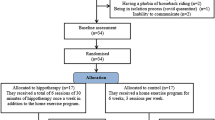Abstract
We compared the degrees of impairment between intended voluntary movement and its simultaneous automatic associated movement in Parkinson's disease (PD). We studied wrist dorsiflexion as a movement associated with grip in 20 patients with PD and in 20 normal controls. The patients showed a significantly smaller dorsiflexion as compared with the controls. The decrease in associated movement was related to the severity of clinical stage of the disease, while gripping was performed well in each stage. The temporal relationship between grip and associated movement was the same for both groups of subjects. The patients showed no disturbance of amplitude or velocity for a single motor act of wrist dorsiflexion. Persons with PD have a greater reduction of automatic associated movement than intended voluntary movement. This may be one of the bases of clinical symptoms of PD patients in early stages of the disease.
Similar content being viewed by others
References
Bazalgette D, Zattara M, Bathien N, Bouisset S, Rondot P (1986) Postural adjustments associated with rapid voluntary arm movements in patients with Parkinson's disease. Adv Neurol 45:371–374
Connor NP, Abbs JH, Cole KJ, Gracco VL (1989) Parkinsonian deficits in serial multiarticulate movements for speech. Brain 112:998–1009
Cordo PJ, Nashner LM (1982) Properties of postural adjustments associated with rapid arm movements. J Neurophysiol 47:287–302
DeLong MR, Georgopoulos AP (1981) Motor functions of the basal ganglia. In: Brookhart JM, Mountcastle VB (eds) Handbook of physiology, the nervous system. American Physiological Society, Bethesda, pp 1017–1061
DeLong MR, Strick PL (1974) Relation of basal ganglia, cerebellum, and motor cortex units to ramp and ballistic limb movements. Brain Res 71:327–335
Dick JPR, Rothwell JC, Berardelli A, Thompson PD, Gioux M, Benecke R, Day BL, Marsden CD (1986) Associated postural adjustments in Parkinson's disease. J Neurol Neurosurg Psychiatry 49:1378–1385
Friedli WG, Hallett M, Simson SR (1984) Postural adjustments associated with rapid voluntary arm movements. 1. Electromyographic data. J Neurol Neurosurg Psychiatry 47:611–622
Fukuda T (1961) Studies on human dynamic postures from the viewpoint of postural reflexes. Acta Otolaryngol (Stockh) [Suppl] 161:1–52
Gahery Y (1987) Associated movements, postural adjustments and synergy: some comments about the history and significance of three motor concepts. Arch Ital Biol 125:345–360
Hallett M, Khoshbin S (1980) A physiological mechanism of bradykinesia. Brain 103:301–314
Hallett M, Shahani BT, Young RR (1977) Analysis of stereotyped voluntary movements at the elbow in patients with Parkinson's disease. J Neurol Neurosurg Psychiatry 40:1129–1135
Hoehn MM, Yahr MD (1967) Parkinsonism: onset, progression, and mortality. Neurology 17:427–442
Hughes AJ, Daniel SE, Kilford L, Lees AJ (1992) Accuracy of clinical diagnosis of idiopathic Parkinson's disease: a clinico-pathological study of 100 cases. J Neurol Neurosurg Psychiatry 55:181–184
Jenkins IH, Fernandez W, Playford ED, Lees AJ, Frackwiak RSJ, Passingham RE, Brooks DJ (1992) Impaired activation of the supplementary motor area in Parkinson's disease is reversed when akinesia is treated with apomorphine. Ann Neurol 32:749–757
Kaneoke Y, Koike Y, Sakurai N, Takahashi A, Watanabe S (1989) Reaction times of movement preparation in patients with Parkinson's disease. Neurology 39:1615–1618
Kleist K (1919) Zur Auffassung der subkortikalen Bewegungsstörungen. Arch Psychiatr Nervenkr 59:790–803
Lakke JPWF (1985) Axial paraxia in Parkinson's disease. J Neurol Sci 69:37–46
Lakke JPWF, Wiegman J (1982) Abnormalities in postural reflexes and voluntary induced automatic movements in Parkinson's patients. Clin Neurol Neurosurg 84:227–235
Livingstone RB, Paillard J, Tournay A, Fessard A (1951) Plasticité d'une synergie musculaire dans l'exécution d'un mouvement volontaire ches l'homme. J Physiol (Paris) 43:605–619
Marsden CD (1982) The mysterious motor function of the basal ganglia (The Robert Wartenberg lecture). Neurology 32:514–539
Martin JP (1967) The basal ganglia and posture. Pitman, London
Mink JW, Thach WT (1991) Basal ganglia motor control. III. Pallidal ablation: normal reaction time, muscle contraction and slow movement. J Neurophysiol 65:330–351
Mushiake H, Inase M, Tanji J (1990) Selective coding of motor sequence in the supplementary motor area of the monkey cerebral cortex. Exp Brain Res 82:208–210
Rascol OJ, Chollet F, Montastruc JL, Marc-Vergnes JP, Rascol A (1993) Impaired activity of the supplementary motor area in akinetic patients with Parkinson's disease. Arch Neurol 60:419–421
Rogers MW, Kukulka CG, Soderberg GL (1987) Postural adjustments preceding rapid arm movements in parkinsonian subjects. Neurosci Lett 75:246–251
Schwab RS, England ACJ (1968) Parkinson syndromes due to various specific causes. In: Vinken PJ, Bruyn GW (eds) Handbook of clinical neurology, vol 6. North-Holland, Amsterdam, pp 227–247
Wilson SAK (1925) Disorders of motility and of muscle tone, with special reference to the corpus striatum. Lancet II:1–10, 53–62, 169–178, 215–219, 268–279
Zülch KJ, Müller N (1969) Associated movements in man. In: Vinken PJ, Bruyn GW (eds) Handbook of clinical neurology, vol 1. North-Holland, Amsterdam, pp 404–426
Author information
Authors and Affiliations
Rights and permissions
About this article
Cite this article
Hoshiyama, M., Kaneoke, Y., Koike, Y. et al. Hypokinesia of associated movement in Parkinson's disease: A symptom in early stages of the disease. J Neurol 241, 517–521 (1994). https://doi.org/10.1007/BF00873512
Received:
Revised:
Accepted:
Issue Date:
DOI: https://doi.org/10.1007/BF00873512




